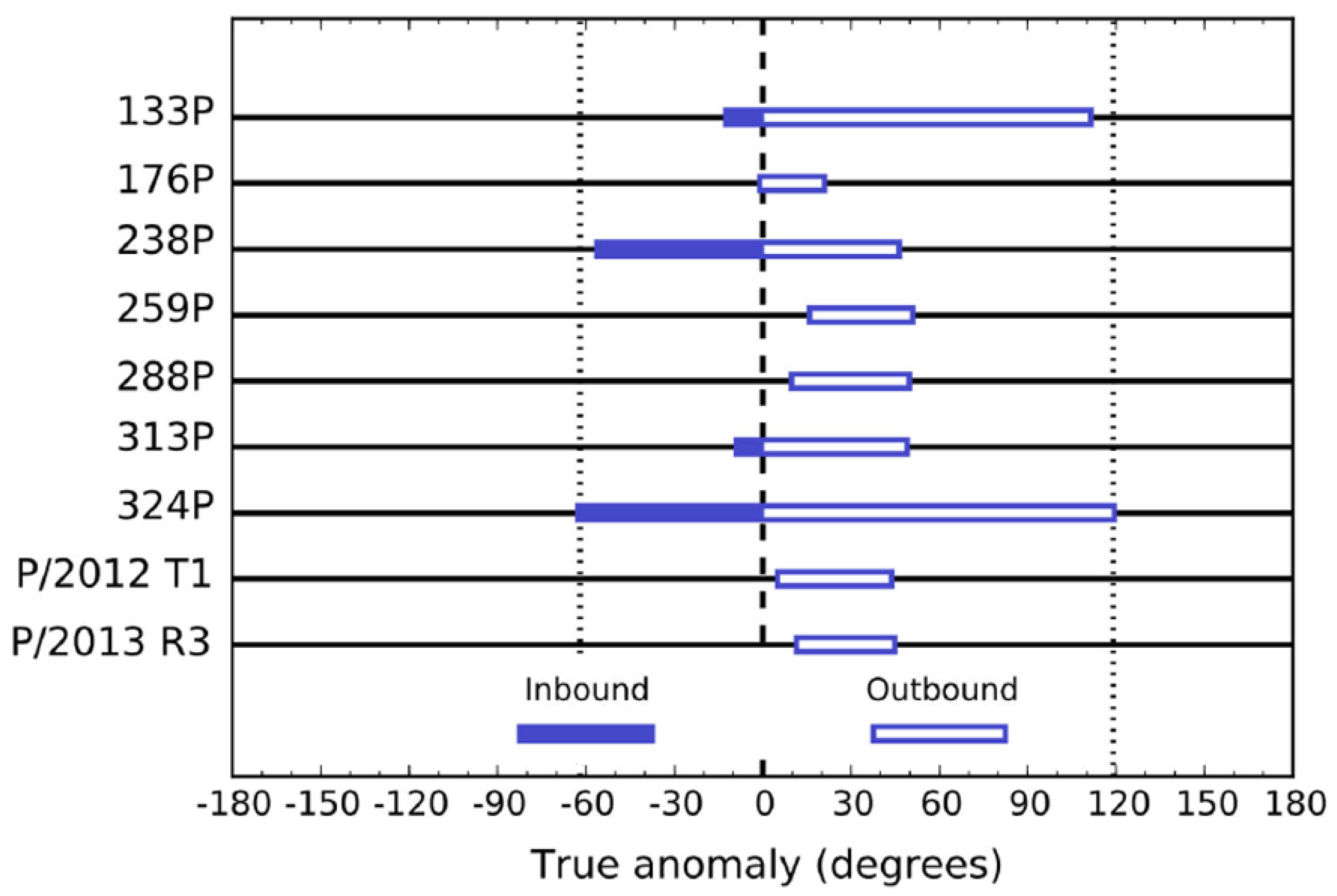Universe, Free Full-Text
Por um escritor misterioso
Last updated 01 abril 2025

According to traditional ideas about the formation of the Solar System starting from a protoplanetary disk of gas and dust, a well-defined distribution of planets and minor bodies is expected: (a) volatile-poor rocky bodies (terrestrial planets and asteroids) in the inner part of the Solar System and (b) volatile-rich objects (gaseous giant planets, comets, Centaurs, and trans-Neptunian objects) in the outer part. All these bodies are expected to orbit near a plane (the ecliptic) coinciding with that of the protoplanetary disk. However, in the modern Solar System many bodies are present that do not respect this simplistic expectation. First of all, there are the so-called Main Belt Comets, apparently asteroidal objects that show an activity similar to that of comets. In addition, there is an object (and several others very probably exist), which, despite its S-type spectrum characteristic of rocky bodies, is found on a cometary orbit. Finally, there are many asteroids on very inclined orbits with respect to the ecliptic. These very interesting groups of objects, which, according to the traditional point of view, could be collectively seen as some sort of “interlopers” of the Solar System, will be discussed in this review, which offers descriptions of their properties and their likely origin. In this respect, the possibility is discussed that many active asteroids (such as those belonging to the Taurid Complex) are the result of the fragmentation of large comets that occurred in the relatively recent past.

Warhammer 40k Escalation League @ Game Universe Franklin — Game Universe

The Wolf in Underpants Breaks Free - Lerner Publishing Group

Calaméo - Before The Big Bang The Origin Of Our Universe From The Multiverse

The Map of the Universe

Feel free to rp: Pearl (Steven universe) by CanisLupus2020 on DeviantArt

Universe, Free Full-Text, Universal Hyperbolic Geometry, Sydpoints and Finite Fields: A Projectiv…
A complete history of the universe, spanning 13.8 billion years in an ultra-accessible, uncommonly illuminating, exhilarating chronicle of key events,

Shortest History of Our Universe: The Unlikely Journey from the Big Bang to Us

Full yellow moon with Craters in the Universe. 5744520 Vector Art at Vecteezy

5,427 Big Shine Moon Royalty-Free Images, Stock Photos & Pictures
Recomendado para você
-
GB Clube - Apps on Google Play01 abril 2025
-
 O melhor XML para Gcam 8.6 - A Monaliza, Freezão 😍01 abril 2025
O melhor XML para Gcam 8.6 - A Monaliza, Freezão 😍01 abril 2025 -
GB Clube for Android - Free App Download01 abril 2025
-
 Gcam Brasil - Como importar presets do Lightroom01 abril 2025
Gcam Brasil - Como importar presets do Lightroom01 abril 2025 -
 🔥 SAIU!! NOVA XML iPHONE 14 PARA GCAM NIKITA 2.O / QUALIDADE01 abril 2025
🔥 SAIU!! NOVA XML iPHONE 14 PARA GCAM NIKITA 2.O / QUALIDADE01 abril 2025 -
 👑 A incrível XML iPHONE 13 PRO V2 Para GCAM BSG 8.101 abril 2025
👑 A incrível XML iPHONE 13 PRO V2 Para GCAM BSG 8.101 abril 2025 -
 O MAIS BRABO DE TODOS - XML MONSTER ESTÁ DE VOLTA ☠️ - GCAM LMC01 abril 2025
O MAIS BRABO DE TODOS - XML MONSTER ESTÁ DE VOLTA ☠️ - GCAM LMC01 abril 2025 -
 Richard - Gcam Brasil01 abril 2025
Richard - Gcam Brasil01 abril 2025 -
 Tabela comparativa dos chips Radeon da AMD (notebooks) - Vídeo01 abril 2025
Tabela comparativa dos chips Radeon da AMD (notebooks) - Vídeo01 abril 2025 -
 Z390 aorus pro não da vídeo na primeira vez que é ligado (luz boot01 abril 2025
Z390 aorus pro não da vídeo na primeira vez que é ligado (luz boot01 abril 2025
você pode gostar
-
 A Pregação de uma Igreja Bíblica - Segunda Igreja Batista em Goiânia01 abril 2025
A Pregação de uma Igreja Bíblica - Segunda Igreja Batista em Goiânia01 abril 2025 -
 Palmeiras x Goiás: prováveis escalações, onde assistir e arbitragem01 abril 2025
Palmeiras x Goiás: prováveis escalações, onde assistir e arbitragem01 abril 2025 -
 Geoestatística no R - Lição 22: Fenômeno Isotrópico - GEOKRIGAGEM01 abril 2025
Geoestatística no R - Lição 22: Fenômeno Isotrópico - GEOKRIGAGEM01 abril 2025 -
 How to install webMAN and multiMAN on 4.89.1 HFW (HEN)01 abril 2025
How to install webMAN and multiMAN on 4.89.1 HFW (HEN)01 abril 2025 -
 All Of These LuxEye Items Went Offsale01 abril 2025
All Of These LuxEye Items Went Offsale01 abril 2025 -
 /wp-content/sites/pockettacti01 abril 2025
/wp-content/sites/pockettacti01 abril 2025 -
 MATANDO STREAMERS FAMOSOS DE TWITCH por 200USD01 abril 2025
MATANDO STREAMERS FAMOSOS DE TWITCH por 200USD01 abril 2025 -
 Rod Wave - Checkmate (Lyrics)01 abril 2025
Rod Wave - Checkmate (Lyrics)01 abril 2025 -
 liberando fotos sad boy|Pesquisa do TikTok01 abril 2025
liberando fotos sad boy|Pesquisa do TikTok01 abril 2025 -
OnlyFans model asked football club if could film adult content at01 abril 2025
